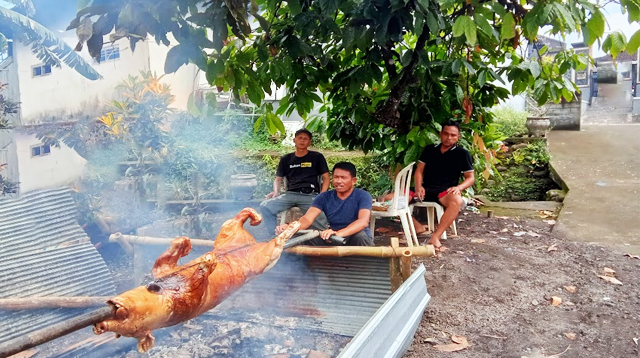BALI Island is a tropical paradise that blends natural beauty with cultural richness. However, among the majestic temples and verdant terraced rice fields, one thing is inseparable from the Balinese identity: the fragrant and mouth-watering aroma of spices from the legendary dish Babi Guling or roasted suckling pig. More than just a dish, Babi Guling reflects the traditions, rituals, and authentic communal life of the Balinese people, captivating both locals and tourists.
What is Babi Guling?
Literally, “Babi Guling” means roasted (suckling) pig. This dish consists of a whole pig that is cleaned and its stomach stuffed with a unique Balinese spice mixture called basa genep and boiled cassava leaves. This basa genep is the key to Babi Guling’s flavor. This spice blend is complex, consisting of shallots, garlic, ginger, turmeric, chilies, galangal and various other ground spices.
After the pig’s belly is filled with boiled cassava leaf mixed with basa genep, sewn back together, the pig is roasted over hot coals, constantly turning until perfectly cooked and the skin is golden-crispy.
This slow, even roasting process ensures the pork is incredibly tender and the spices penetrate deeply. The result is a harmonious blend of flavors: crispy, savory skin, tender, richly spiced meat, and a truly enticing aroma. When served, Babi Guling is usually accompanied by warm rice, lawar (a mixture of vegetables and minced pork), urutan (Balinese pork sausage), and sometimes komoh (pork soup).
Babi Guling for Rituals and Consumption
Babi Guling’s role in Balinese culture is highly sacred. Originally, this dish was not intended for daily consumption, but rather as a primary offering in various religious ceremonies. In Balinese Hinduism, pigs symbolize prosperity and fertility. Therefore, offering a whole pig to be made into Babi Guling is an expression of gratitude and the ultimate offering to the gods.
When is Babi Guling Made for Rituals?
Suckling pigs are made for rituals at important moments in Balinese life, including:
- Piodalan: A ceremony commemorating a temple’s anniversary. Suckling pigs are the main offering that marks the festive occasion.
- Ninggungin: An offering as a form of thanksgiving for a sow thathas successfully given birth to a number of healthy offspring. At a certain age, one of them will be slung over.
- Paying a vow (sesangi): If someone makes a vow and their wish is fulfilled, they will offer aroasted suckling pig at the family temple or sacred place where they made the vow.
- Tumpek Landep: A ceremony dedicated to blessing sharp objects, where suckling pigs are often included as part of the offerings.
In a ritual context, the process of making suckling pigs is a communal activity involving all members of the family or even the banjar (subvillage community). It is a moment of togetherness where everyone plays a role, from preparing the spices to roasting. Roasted suckling pigs made for rituals have a profound meaning; they are not simply delicious food, but a form of sacred sacrifice that strengthens human relationships with other people, ancestors and gods.
Over time, Babi Guling has evolved from a ritual dish into a culinary icon enjoyed daily. Many food stalls and restaurants throughout Bali serve Babi Guling as their signature dish, making it accessible to everyone, both locals and tourists.
Traditional Balinese Food and Tourist Attraction
As one of the most iconic dishes, Babi Guling is an authentic representation of Bali’s rich culinary heritage. The rich and complex basa genep spices are a hallmark that distinguishes it from other dishes. Each stall or family has its own secret for blending these spices, creating unique flavor variations in each location.
Babi Guling’s appeal to tourists is immense. For many travelers, culinary experiences are an integral part of their vacation. Sampling Babi Guling isn’t just about eating, but about experiencing Balinese culture firsthand.
- Authentic Culinary Experience: Tourists seek out unusual experiences. Seeing Babi Guling being roasted live, smelling its distinctive aroma, and eating it in a simple food stall provides an authentic experience that’s hard to forget.
- Appetizing Flavor: The combination of spicy, savory, and fragrant spices is an adventure for the palate. The sensation of crispy skin combined with tender pork meat makes many tourists addicted.
- Cultural Symbol: Babi Guling is the easiest way to understand part of Balinese culture. The story behind the ritual, its philosophical meaning, and how it is prepared are fascinating stories that are often sought by tourists.
Several places in Bali, particularly Ubud and Denpasar, have even become landmarks for Babi Guling lovers. People are willing to queue for a plate of Babi Guling at legendary stalls, proving that this dish has become a powerful tourist attraction.
Overall, Babi Guling is a harmonious blend of tradition and modernity. It remains an important part of religious ceremonies while also becoming a global favorite. Through each piece of meat and its crispy skin, Babi Guling not only delivers deliciousness but also tells a story of identity, spirituality, and communal warmth found only on the Island of the Gods. (*)










